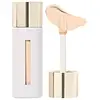Ami Colé Lash-Amplifying Mascara Versus Westman Atelier Vital Skincare Brightening Concealer With Hyaluronic Acid
What's inside
What's inside
 Key Ingredients
Key Ingredients

 Benefits
Benefits

 Concerns
Concerns

 Ingredients Side-by-side
Ingredients Side-by-side

Water
Skin ConditioningSynthetic Beeswax
Emulsion StabilisingGlyceryl Stearate
EmollientJojoba Esters
EmollientGlycerin
HumectantCopernicia Cerifera Wax
Stearic Acid
CleansingPalmitic Acid
EmollientButyrospermum Parkii Butter
Skin ConditioningPolyacrylate-21
Caprylyl Glycol
EmollientPropanediol
SolventAcacia Senegal Gum
MaskingHydroxyethylcellulose
Emulsion StabilisingSodium Hydroxide
BufferingButylene Glycol
HumectantCaprylhydroxamic Acid
Trideceth-6 Phosphate
EmulsifyingLauric Acid
CleansingMyristic Acid
CleansingArachidic Acid
CleansingDipropylene Glycol
HumectantOleic Acid
EmollientGlyceryl Caprylate
EmollientTocopherol
AntioxidantPotassium Sorbate
PreservativeCI 77499
Cosmetic ColorantWater, Synthetic Beeswax, Glyceryl Stearate, Jojoba Esters, Glycerin, Copernicia Cerifera Wax, Stearic Acid, Palmitic Acid, Butyrospermum Parkii Butter, Polyacrylate-21, Caprylyl Glycol, Propanediol, Acacia Senegal Gum, Hydroxyethylcellulose, Sodium Hydroxide, Butylene Glycol, Caprylhydroxamic Acid, Trideceth-6 Phosphate, Lauric Acid, Myristic Acid, Arachidic Acid, Dipropylene Glycol, Oleic Acid, Glyceryl Caprylate, Tocopherol, Potassium Sorbate, CI 77499
Water
Skin ConditioningC9-12 Alkane
SolventOctyldodecyl Neopentanoate
EmollientGlycerin
HumectantDiisostearoyl Polyglyceryl-3 Dimer Dilinoleate
EmollientSodium Potassium Aluminum Silicate
Disteardimonium Hectorite
StabilisingCaprylic/Capric Triglyceride
MaskingTribehenin
EmollientHelianthus Annuus Seed Oil
EmollientGlycyrrhiza Glabra Root Extract
BleachingGentiana Lutea Root Extract
Skin ConditioningCoffea Arabica Seed Extract
MaskingPalmitoyl Pentapeptide-4
Skin ConditioningHydrolyzed Sodium Hyaluronate
Skin ConditioningCoco-Caprylate/Caprate
EmollientDisodium Stearoyl Glutamate
CleansingSodium Chloride
MaskingCaprylyl Glycol
EmollientPropylene Carbonate
SolventPotassium Sorbate
PreservativeSilica
AbrasivePropanediol
SolventAluminum Hydroxide
EmollientCitric Acid
BufferingCI 77891
Cosmetic ColorantWater, C9-12 Alkane, Octyldodecyl Neopentanoate, Glycerin, Diisostearoyl Polyglyceryl-3 Dimer Dilinoleate, Sodium Potassium Aluminum Silicate, Disteardimonium Hectorite, Caprylic/Capric Triglyceride, Tribehenin, Helianthus Annuus Seed Oil, Glycyrrhiza Glabra Root Extract, Gentiana Lutea Root Extract, Coffea Arabica Seed Extract, Palmitoyl Pentapeptide-4, Hydrolyzed Sodium Hyaluronate, Coco-Caprylate/Caprate, Disodium Stearoyl Glutamate, Sodium Chloride, Caprylyl Glycol, Propylene Carbonate, Potassium Sorbate, Silica, Propanediol, Aluminum Hydroxide, Citric Acid, CI 77891
 Reviews
Reviews

Ingredients Explained
These ingredients are found in both products.
Ingredients higher up in an ingredient list are typically present in a larger amount.
Caprylyl Glycol is a humectant and emollient, meaning it attracts and preserves moisture.
It is a common ingredient in many products, especially those designed to hydrate skin. The primary benefits are retaining moisture, skin softening, and promoting a healthy skin barrier.
Though Caprylyl Glycol is an alcohol derived from fatty acids, it is not the kind that can dry out skin.
This ingredient is also used as a preservative to extend the life of products. It has slight antimicrobial properties.
Learn more about Caprylyl GlycolGlycerin is already naturally found in your skin. It helps moisturize and protect your skin.
A study from 2016 found glycerin to be more effective as a humectant than AHAs and hyaluronic acid.
As a humectant, it helps the skin stay hydrated by pulling moisture to your skin. The low molecular weight of glycerin allows it to pull moisture into the deeper layers of your skin.
Hydrated skin improves your skin barrier; Your skin barrier helps protect against irritants and bacteria.
Glycerin has also been found to have antimicrobial and antiviral properties. Due to these properties, glycerin is often used in wound and burn treatments.
In cosmetics, glycerin is usually derived from plants such as soybean or palm. However, it can also be sourced from animals, such as tallow or animal fat.
This ingredient is organic, colorless, odorless, and non-toxic.
Glycerin is the name for this ingredient in American English. British English uses Glycerol/Glycerine.
Learn more about GlycerinPotassium Sorbate is a preservative used to prevent yeast and mold in products. It is commonly found in both cosmetic and food products.
This ingredient comes from potassium salt derived from sorbic acid. Sorbic acid is a natural antibiotic and effective against fungus.
Both potassium sorbate and sorbic acid can be found in baked goods, cheeses, dried meats, dried fruit, ice cream, pickles, wine, yogurt, and more.
You'll often find this ingredient used with other preservatives.
Learn more about Potassium SorbatePropanediol is an all-star ingredient. It softens, hydrates, and smooths the skin.
It’s often used to:
Propanediol is not likely to cause sensitivity and considered safe to use. It is derived from corn or petroleum with a clear color and no scent.
Learn more about PropanediolWater. It's the most common cosmetic ingredient of all. You'll usually see it at the top of ingredient lists, meaning that it makes up the largest part of the product.
So why is it so popular? Water most often acts as a solvent - this means that it helps dissolve other ingredients into the formulation.
You'll also recognize water as that liquid we all need to stay alive. If you see this, drink a glass of water. Stay hydrated!
Learn more about Water